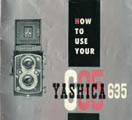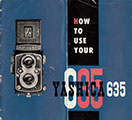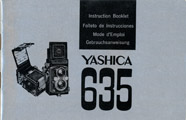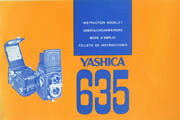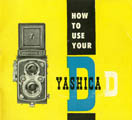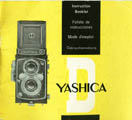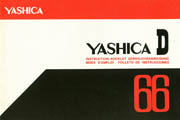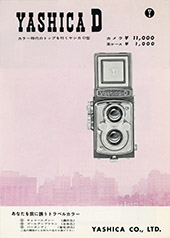66 Models
1958 to 1959
Yashica 635 to Yashica Auto
The 66 Models are in chronological release date order split over seven pages to assist with the speed of displaying images.
The background to 66 Models and the various notes are at the beginning of the first page, 1953-1954.
Models
(Scrolling will take you down to the bottom of the page that you are on, clicking on links will take you to that model regardless of the page that you are on.)
1953-1954 The Simple Beginning |
||
| Pigeonflex | Yashima Flex | |
| Yashica Flex B | ||
1954 A Step Up - Japanese Icon |
||
| Yashica Flex S | ||
1954-1955 Full Range of Models Released |
||
| Yashicaflex A-I | Yashicaflex A-II | |
| Yashicaflex AS-I | Yashicaflex AS-II | |
| MolfoReflex | Yashicaflex C | |
| Yashicaflex A-III | ||
1956-1957 The “Yashica” is born |
||
| Yashica Rookie | Yashica Hi-Mec | |
| Yashica A | Yashica C | |
| Yashica LM | Yashicaflex A2 | |
1957 First Crank Wind and Last “Yashicaflex” models |
||
| Yashica-Mat | Yashicaflex AS (new model) | |
| Yashicaflex B (new model) | Yashicaflex A (new model) | |
1958-1959 The Classics, the 635 and D, Released |
||
| Yashica 635 | Yashica B | |
| Yashica D | Yashica A III | |
| Yashica Auto | ||
1960-1986 Crank Wind Sophistication plus Automation |
||
| Yashica Mat-LM | Yashica E | |
| Yashica Mat-EM | Yashica 24, 12 & Mat-124 | |
| Yashica Mat-124G | Yashica Mat-124B | |
Yashica 635
Knob wind premium model with control wheels and 35 mm film capability
Probable release date |
Jun 1958 |
Probable end date |
Oct 1971 |
Lens |
Filter Mounts |
Frame Counter |
Shutter |
|||
Make/Type |
Sync |
S/Timer |
Speeds |
|||
Yashikor |
Bay 1 |
Counter |
Copal MXV |
M/X |
Yes |
B,1-1/500 |
Yashinon |
Bay 1 |
Counter |
Copal MXV |
M/X |
Yes |
B,1-1/500 |
| Yashinon and f/2.8 viewing lens replaced Yashikor Sep 1970 | ||||||
(Click on 1st cover for PDF of full first version manual provided courtesy of Bill Barr or on 3rd cover for the full multi-lingual version in use from the mid to late 1960s. Blue cover second version is the same as first except shutter speeds are updated to the “modern” sequence, e.g., 1/125 instead of 1/100. Gold cover multi-lingual version updates the content to match the late Yashinon lens version. Basic operations are the same in all.)
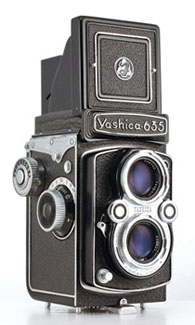
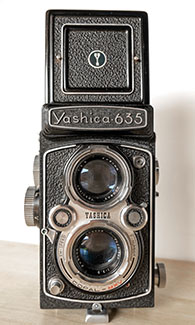
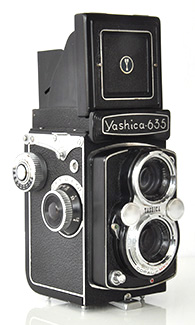

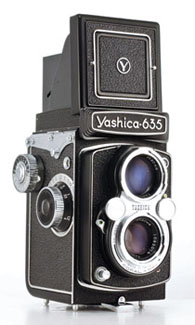
(1st and 5th images courtesy of Tom Heckhaus, 2nd image courtesy of Gordon Brown, 3rd image courtesy of Göran Årelind)
The Camera
The derivation of the 635 name is pretty obvious; “6” for 6 x 6 cm and “35” for 35 mm.
The first camera above is not the earliest 1958 trim, it already has the later combined ASA/DIN reminder on the winding knob which replaced the 9 flag ASA type very early on and the “Yashica” in block letters between the lenses which replaced the oval version a little later. The earliest version below is the earliest production 635 in my database, serial number 58431:
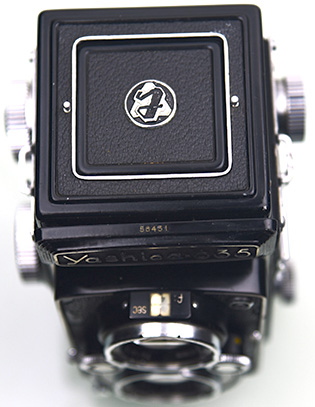
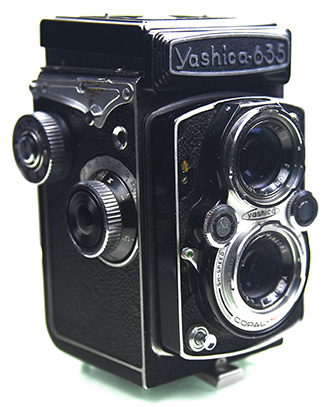


(Images courtesy of Göran Årelind)
Like the earliest Yashica-Mat in my database, it has been found in Sweden by contributor Göran Årelind. As we shall see, one thing that makes this camera unusual is the metric focus knob shared by only one other early example. Note, this camera has the typical early accessory shoe engraved with “Made in Japan” (explained further down) but it has been reverse mounted by a previous owner and is consequently upside down.
The second camera at the top has the narrow “Y” hood logo on a blue background which arrived in about March 1960 and the third camera ads the dull silver control wheels that arrived before November 1960. The fourth camera has shiny control wheels (1965) and the new wide “Y” hood logo (1966).
The fifth camera looks similar but is one of the last and has Yashinon lenses with f/2.8 viewing lens, introduced together in September 1970, and adds a black locking knob (inherited from the Yashica Mat-124G) and textured nameplate common also to the same vintage Yashica-Mat and Yashica D (note, although all the changes occurred in September 1970, the Yashinons came first, followed by the nameplate and then the locking knob, probably as parts were used up):

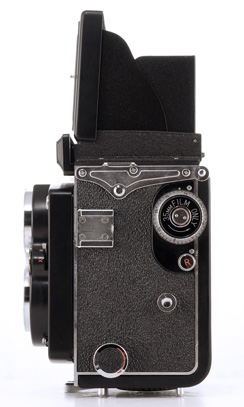
.jpg)

(Images courtesy of Tom Heckhaus)
Almost identical to the preceding Yashicaflex B (new model) and following Yashica D in other respects, it has the unique ability amongst Yashica TLRs to shoot 35mm when the supplied kit is installed in the camera. Loading and winding 120 film is identical to other knob wind auto-stop models. With the 35 mm kit fitted, all film winding and rewinding is taken care of by the controls on the spool knob side.
35 mm Capability - General
The Yashica 635 is not the only 35 mm equipped 6 x 6 TLR. The Rolleis had the Rolleikin adaptor kit which first appeared in 1933. The original kit required a new back in addition to the film guide and spool adapters. There was also the Rolleikin 1 which I know little about and may have been similar to the Rolleikin 2 but included a special back for later models without a dual format pressure plate. The Rolleikin 2 didn't include a special back but did require some dismantling and replacement of the spool knobs. It seems to fit all post 1949 Rollei TLRs except the 44 and Magic models. The Rolleikin C (I have seen it referred to as both the “C” and “2C”) is basically the same kit without the replacement 35 mm film winder/counter for those early 2.8 models, starting with the 2.8C in 1953, with the winder/counter already installed, much like on the Yashica 635.
The mid-1950s Meopta Flexaret IVa introduced built-in 35 mm capability which continued with future models (except the return to basics “Standard” of 1965) but a rewind button didn't come until the Va. Similar kits to the Rolleis and Yashica 635 were still required (there were several variations) but an additional film counter counting in tens was built-in as was a 35 mm sports finder flap in the centre of the larger 6 x 6 cm one.
The budget geared lens Super Ricohflex TLR released in 1956 had an optional 35 mm film insert which filled most of the camera's empty insides. This was called the “Ricohflex Color-Back” - a clue to answer my question which follows shortly. The much more sophisticated 1959 crank-wind Ricohmatic 225, a development of the Diacord series, was supplied “With Color-Back 225” on the box - a typical 35 mm kit similar to the Yashica 635 one.
Why would anyone want to shoot 35 mm in a medium format camera? These days, we tend to think of a separate tool for every little nuance but in the less affluent times of the 1950s and 60s, perhaps people were more prepared to compromise to have the convenience of both formats, particularly if 35 mm was only an infrequent need. Initially, colour film was not available in the larger size and I have seen it suggested that Kodachrome slide film was also a factor - this was not available in 120 size until the mid to late 1980s. These days, the main reason for shooting 35 mm in a 635 is to have fun. Often, people mention the advantage of using 35 mm for portraits. It is true that by its design and portrait orientation for 35 mm, ergonomically the TLR is a great tool for shooting portraits and the 80 mm normal length 6x6 lens becomes a mid-length (but still shortish) 35 mm portrait lens, however, image quality remains a compromise. Yes, only the best central part of the image circle is being used for 35 mm but in general, 35 mm lenses are more highly corrected and offer a higher resolution to partially offset the advantage of the larger 120 format.
(If portrait image perspective is a concern, there are three alternatives; the 635 with 35 mm kit, an auxiliary telephoto lens or simply increasing the the camera to subject distance, increasing the amount of image enlargement and cropping to suit. All three have an impact on ultimate image quality but that maybe largely unnoticeable depending on display mediums, sizes etc.)
Yashica 635 35 mm Kit
Included in the kit are two spool adaptors for the 35 mm cartridge, a 35 mm take up spool, a pressure plate/ film guide/ sprocket assembly for 35 mm, an insert for the sports finder and a leather case. The two images below are scans from the user manual:


The lower scan shows the film guide/ sprocket assembly installed in the camera without the pressure plate (note that the rewind release button, “R”, must be locked out for installation and then released when assembly is complete). The pressure plate lifts off to load film and is located by the two pins attached to either side.
The 35 mm kits are most often typified by the case styles - there are four known types. The first kits feature a brown leather case with the full model name, “Yashica 635”, in text which somewhat matches the style of the camera's nameplate:
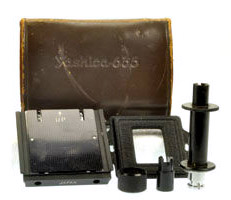 (Image courtesy of Tom Heckhaus)
(Image courtesy of Tom Heckhaus)
The kit below has the the second style brown case with “Yashica” now in the heavy serif “Wild West” type font. It probably appeared in 1960 but still matches my 1967 camera, shown fitted with the 35 mm mask for the focusing hood, and its brown ever-ready case:


These photos show the kit fitted and also the camera back with cut-outs in the pressure plate for the 35 mm sprockets and the extra guide roller at the bottom in place of the usual fixed bar on other models (except the Yashica Mat-124G which also uses a roller):

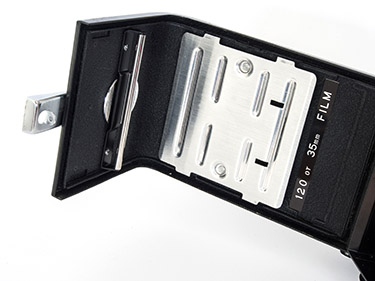
The black leather case below is the third style and belongs to a later camera with black ever ready case. Note, the pressure plate is shown assembled onto the film guide/ sprocket assembly:

(Image courtesy of Göran Årelind)
The last type features a similar black case but with “Yashica” in the modern sans serif font.
 (Detail from larger web image)
(Detail from larger web image)
35 mm Kit Variations
As far as the kit itself, there don't appear to be any changes to how it fits or other significant design alterations. There are some minor differences though. The film guide design changed by, or more likely prior to, the introduction of the second brown kit case. Although the scans at the top are from the same user manual (third type above), the second scan shows the updated later guides with narrow runner strip (as in the photos of the second type above) and the top scan from the same manual shows the original wider runner strip that appeared in all relevant photos in the first two manuals. The pictures below show the first type film guide and pressure plate without the word “Up” and the underneath sides (similar to all). Note that the early pressure plate locating pins are black instead of silver on all later versions:
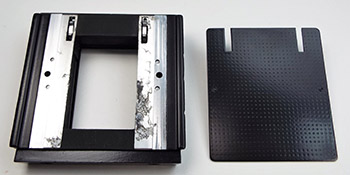

(Images courtesy of Chris Whelan)
Then with the last black kit, the four painted screws in the bottom of the film guide unit (as in the right photo immediately above) are now plated cross head types. Also, with probably the first black kit above but certainly by the second black kit (last type), the female threaded 35 mm spool support has been modified. In the parts diagram above found in the earlier three user manuals, it is “(9) Metal Adapter Ring” and in the final manual it is described as “(10) Spacer Ring”. In the two earlier kits, the threaded insert is clearly brass whereas in the first black kit above (there may be two versions of the black kit too, one with some earlier parts) it is silver - either plated or aluminium. Also, whereas previously the outer part had a hollow with a central pin or shaft to hold the 35 mm cassette shaft, the centre pin part has been eliminated (it served no useful purpose) and the threaded insert is open at both ends. This has no impact on any other parts or the functionality of the cassette support. First two images are bottom and top views of the earlier spacer, the third image is top view of the last type spacer:


 (Image 3 is detail from larger web image)
(Image 3 is detail from larger web image)
Oddity
A little while ago, a correspondent contacted me with some questions about his 635. It was a very nice example from April 1967 (SX 704etc) but normally, all 635s have a modified spool support on the bottom right when holding the camera. On other models, there is the support shaft and then a collar which acts as a spacer. The collar on the 635 is male threaded to accept “(9) Metal Adapter Ring” shown in the diagram above and discussed in the previous paragraph. The thread has no effect on 120 spools whatsoever. His camera didn't have the thread. The obvious answer is that someone has modified it with a part from a different model but that is in fact fairly unlikely. It is a non-moving part that doesn't show any wear even when extreme wear and mis-treatment is evident elsewhere. To replace it would require the leatherette covering to be removed - there are no obvious signs of that. It seems far more likely that this is a factory mistake. I can confirm that my slightly later SX 7091463 is threaded. Correspondent's camera on the left.
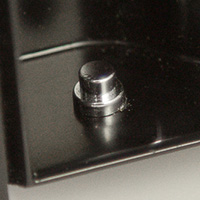
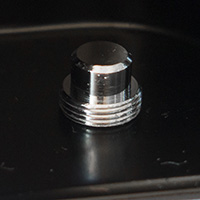
Trim & Feature Changes
According to Karl Kahlau's Yashica/Kyocera documentation, the Yashica 635 was released a few months earlier than the Yashica D. He doesn't have an end date but according to the website “A Partial History of Yashica TLRs”, using similar source material, it lasted until 1972 or 1973 but by serial numbers, I have only found evidence of production up to 1971 so far.
As expected, the trim changes somewhat mirror the Yashica-Mat and Yashica D. The main exceptions are that there was no coloured leatherette or related gold narrow “Y” hood logo as on the Yashica D, the accessory shoe always had 4 screws as opposed to 0 or 4 on the Yashica D and it seems that the black radial control wheels were implemented and then immediately discarded.
This is the first example in my database with the block letter style “Yashica” between the lenses instead of the previous oval style and the only example with the radial wheels. All later ones have the first type with black leatherette inserts until all models in production moved to the dull silver type.
 (Image courtesy of Glen from “Focus on Newfoundland”)
(Image courtesy of Glen from “Focus on Newfoundland”)
Camera owner Glen of the “Focus on Newfoundland” photography site wrote that the original owner claims that there have been no alterations to the camera. Glen has also heard murmurings from collectors that claim that only a handful of these left the factory. It is the case that when both the Yashica D and Yashica-Mat changed to the block letter style “Yashica” between the lenses, they changed to the radial style wheels at the same time. At that point, both the Yashica D and Yashica-Mat also had seven digit serial numbers commencing with “39” as does this camera. So in terms of the other comparable models, this camera is entirely consistent. The question of course is, why did Yashica revert to the older style control wheels? The earlier wheels were a Rollei copy - was it to emphasise the difference of this more serious camera with the consumer focused Yashica D in its variety of colours at the time? I have also come to realise that Japanese market Yashica Ds never changed to the black radial type, they also kept the leatherette inserts until the advent of the dull silver type (see Yashica D section below).
“Made in Japan” appears in the accessory shoe of the first cameras up to serial number 5860xxx (still in the first month or two of production). It is on all sixteen of the first twenty one cameras in my database where the shoe is visible. Later cameras don't have it. As far as I am aware, it is only found on 66 models on the early Yashica 635 and early coloured Yashica A where it very quickly changed to simply “Japan”.
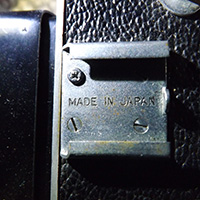 (Image courtesy of Richard Mean, top left screw replaced)
(Image courtesy of Richard Mean, top left screw replaced)
On late cameras, starting in March-April 1968, the slotted accessory shoe screws were replaced with cross head types (almost certainly Japanese JIS standard rather than Phillips - tight screws can be damaged by a Phillips driver). Note, the strap holder screws also changed but not until about August 1970 (Chris Gover's last 635 with Yashikor lenses mentioned below is also the last with slotted screws).
Like with the Yashica D, Mat and other models from the period, “Made in Japan” on the locking knob/tripod mount didn't reappear until 1960 (it had been there on earlier models).
I have not yet found any with internal light baffles and don't expect to because it seemed to be a mainly export focused model and in any case, the 35 mm kit may have interfered with them.
With the Yashica D and Yashica-Mat, all the late examples with f/2.8 (Yashinon) viewing lenses and the last of the examples with f/3.5 (Yashica D Yashikor) viewing lenses and possibly the last f/3.2 (Mat Yashinon) viewing lenses, have MXV shutters with 5 curved aperture blades instead of 10. I haven't been able to track this with the 635 Yashinon lenses but correspondent Chris Gover has sent me details and photos of his 635 which is the last of the Yashikor lens versions (body number 0080xxx - August 1970) and has the 5 bladed aperture. (See 5 and 10 Bladed Apertures)
Japanese Market
Like the Yashica D, the Yashica 635 was a significant export model for Yashica but what of Japan? The Yashica 635 was advertised with its own dedicated 160 page Yashicaflex Photography book in Japanese. Below is part of a Japanese brochure from about 1958 (other pages from the brochure cover the new Yashicaflex A and B and Yashica-Mat). I have seen it in other Japanese brochures and ads as well but without ever finding an example advertised with a metre focusing scale. Detail from this brochure clearly indicates a focusing scale in feet. I have only seen two 635 examples with metric knobs, the earliest example, 58431, found in Sweden and one other early example, by lens numbers, probably earlier than 60000, found in Japan. Japanese market cameras don't usually have the ® mark on the nameplate. The first example in my database with the mark is the eighteenth camera, the first with a seven digit number, 5850xxx instead of the earlier 5 digit numbers (the ® mark had been in use since late 1956 with the first of the Yashica As and Cs.). I have not found any other 635s without the mark in the period that it was in use. Of the seventeen without the mark, I recorded where found for ten of them - one was from Sweden, two the USA and seven Japan. Few later ones turn up on Japanese auction sites which may simply mean that Yashica did not plan to sell enough in Japan to warrant a separate version. Although the camera was advertised in 1958 Japanese brochures, it and the Yashica-Mat had disappeared from the 1959 brochures. On the other hand, how hard is it to make a batch with knobs from a different box (the same style focus knobs were used for all contemporary knob wind models)? A mystery.


(Document images courtesy of Leigh Harris)
Trim & Feature Changes by Serial Number
The camera in the earliest user manual is 56602 with taking lens 981609 and viewing lens 99320x, almost certainly a preproduction example. Found in Sweden and the first of two examples with metric focusing knobs, the earliest production camera is 58431 with taking lens 985085 and viewing lens 761459. The viewing lens number is unique, it is similar to 1961 Yashikor numbers but is also similar to some of the 1957 Yashicaflex B (new model) lens numbers. It would be unusual for only a viewing lens to be changed by someone, I'm inclined to believe that it is from earlier production. Taking lens numbers rise to 999xxx and viewing lenses to 995xxx by camera 598xx before correspondent Jeanie Galvanni's camera 60375 introduces a new lens series with 203521 taking lens and 203213 viewing lens. A slightly later camera has viewing lens 201xxx. In the earlier lens series, a camera found in Japan with 983xxx taking lens and 980xxx viewing lens is the second, and only other, 635 with metric focusing knob. Camera 61xxx, lenses 210xxx and 207xxx, is the last with a five digit serial number.
There are seventeen of these earlier serial number cameras in my database. That is a little mystery, by this stage, most models were using a serial number with date code, the exceptions being the early 635, early Yashica 44 and the very earliest Yashica D examples (released a few months later). They (including the two metric examples) are also the only 635 examples with the 9 flag ASA film speed reminder on the film winding knob. All others have the later combined silver/black DIN/ASA scale. As noted in “Japanese Market”, none of the examples have the ® mark used on export cameras.
The next two cameras have new seven digit numbers, 5850xxx (1958, May), and taking and viewing lens numbers in the 229xxx to 231xxx range. They are the first with the ® mark. This is followed by 5860xxx with taking and viewing lens numbers 405xxx which are in a new range running in conjunction with the earlier range. The next camera, 5860xxx, with lenses 238xxx and 401xxx, is the last in the database to have “Made in Japan” in the accessory shoe. The following cameras continue with a random mix of lenses beginning with “2” or “4” before moving on to “5”. Camera 5871xxx has taking lens number 240xxx and 240xxx viewing lens. Then there are three cameras in a new numbering range with seven digit numbers 3890xxx which translates to 1958, September. The next six cameras have eight digit numbers 38100xxx to 38102xxx and taking lens numbers between 253xxx and 450xxx with viewing lenses between 251xxx and 444xxx, all from October. The next camera has taking lens number 258xxx. Then start a block of cameras with seven digit body numbers commencing with 3910xxx and ending with 3931xxx, January to March 1959. Except for the second last one, all the cameras so far have the “Yashica” oval between the lenses, black leatherette insert ring in the control wheels and the early hood emblem.
With the second last of the group, 3930xxx (lens 488xxx), the “Yashica” oval between the lenses changed to block letters. This is also the only Yashica 635 example with the black radial style control wheels, subsequent cameras have the black ring insert again until the matte silver type. Next is a block of cameras with serial numbers from 4110xxx to 4121xxx and taking lens numbers from 535xxx to 559xxx, all with the earlier control wheels but with the “Yashica” between the lenses in block letters.
Then there is a block of six digit 1960 serial numbers. The first, 610xxx (January) is the first with dual scale focusing knob. Two cameras later, 630xxx, is the first with the narrow “Y” hood logo on a blue background. Camera 670xxx is the last example with leatherette insert in the control wheels.
The next camera is the first with the dull silver control wheels. This has the only 9 digit 635 serial number, 136110xxx, with taking lens 657xxx and viewing lens 658xxx. As discussed on the Serial Numbers page, the “13” is likely to indicate the 635 model, “6” for 1960, “11” for November and the last four digits, the number made so far that month.
This is followed by the first prefixed body serial number, ST 1010xxx, from January 1961. The two screws in the back disappeared by ST 2101xxx. ST 3121xxx is the first with tabbed plastic lens caps instead of the hinged metal type and ST 4050xxx was the last with ST prefix followed by the first with SX prefix, SX 4061xxx.
However, camera ST 612031x turned up with a very clear number and breaks the neat sequence. By hood logo (narrow “Y” on blue background), it belongs in the ST series rather than in the “61” numbers of the SX series. Also, the two screws near the exposure window, the yellow metre scale on the dual scale focusing knob and the two screws in the back (all of which disappeared during 1962) and 665xxx and 666xxx lens numbers date the rest of this camera to near the start of prefix numbers (1961 instead of 1966). I was as certain as I could be that the nameplate (and serial number) originated from the Yashica spares system. Now I am confused. A second 635 has turned up with a very similar number, ST 6120378 and viewing lens 666084, owned by correspondent Vincent Walsh. The fact that the nameplate serial numbers are very close is expected and reinforces my theory but the features and lens numbers suggest that this camera was also made in early 1961. Is that simply a coincidence, or is there something else going on? Don't know. Serial Numbers of Vincent's camera:


(Images courtesy of Vincent Walsh)
SX 5031xxx is the first with the plainer, second type plastic lens caps. At SX 5070xxx, the control wheels changed to the later, shinier type. Around SX 6021xxx (February 1966), the hood emblem changed to the wide “Y” type. The parallel bars on the rear of the focusing hood changed to black with camera SX 7071xxx, around July 1967. Between cameras SX 7122xxx and SX 8020xxx, the satin black focusing hood blind changed to a textured finish. Between cameras SX 8030xxx and SX 8040xxx, the slotted accessory shoe screws changed to a cross head type (probably JIS).
The numbers get to SX 9110xxx (lens number 948xxx) and then start again with SX 0011xxx (January 1970). Camera SX 0080xxx with taking lens 992xxx and viewing lens 997xxx, is the last the last example with Yashikor lenses.
SX 0081xxx introduces the Yashinon taking lens, number 1017xxx, and the f/2.8 viewing lens without serial number, although some immediately following taking lenses have numbers as low as 989xxx. All subsequent lenses are of these types. This camera is also the first using the cross head screws for the strap holders. SX 0094xxx is the first with the new style textured nameplate. Its locking knob is still chrome. There are three other cameras with SX 0094xxx serial numbers; on the first, the knob is not visible but the second is the first example with the black plastic Yashica Mat-124G locking knob. The third reverts to chrome but the following cameras have black knobs. These cameras are all from September 1970. Camera SX 0101xxx from October has the other new features but reverts to a plain nameplate so there was a slightly messy changeover period but only over a month or so. A single December camera also has a chrome locking knob but it may have been changed later or Yashica found an extra one sitting around. Camera SX 1072xxx has the highest taking lens number 1071xxx but the next two cameras, both SX 1081xxx (August 1971), have taking lens numbers 782xxx and 778xxx respectively. These lower numbers belong to a range shared with the late Hong Kong assembled Yashica Ds and the 1971 to 1972 Yashica-Mats and Yashica Mat-124Gs. They are followed by the last Yashica 635 in my database, SX 1101xxx, an October 1971 camera with lens number 776xxx.
Ever Ready & Kit Cases
Another little mystery. The Yashica 635, released in 1958 and seemingly only available with the focusing scale in feet (until dual scales), was clearly an export focused model, although according to brochures, advertised in Japan. There had been no Yashicaflex export models released for several years by now yet the early 635 ever-ready cases have “Yashicaflex” on the front until about 1965 when model names were no longer included. The first cases have the silver Yashica oval also found on late Yashicaflex and early “Yashica” named knob wind model cases. It is noteworthy that whilst the Yashica A, B, D and Auto moved to, or started with, the narrow “Y” on gold background which first appeared on camera cases in late 1958, the Yashica 635 was the only model to retain the oval on the case until the new narrow “Y” on enamelled white background arrived in about 1964. “Yashicaflex” was still on the front:
 (Detail from larger web image)
(Detail from larger web image)
A unique kit case, called “compartment case” by Yashica, was also available for this model to hold both the camera and the the 35 mm kit. All the earlier ones that I have seen are marked “Yashica 635” and later ones simply “Yashica”. No mention of “Yashicaflex”. This may be part of the answer. It featured in the first three of the four user manuals at the top of this section rather than the usual instructions on how to remove the ever-ready case and is mentioned in several ads and brochures as being included in the price. In the last manual featuring Yashinon lenses (1970), the compartment case is not mentioned and the instructions revert to the removal of the ever-ready case. It is possible that the earlier ever-ready cases, were only supplied as optional extras. So far, I have not seen a 635 for sale with both ever-ready and compartment cases, only one or the other. But it still doesn't explain Yashica's thinking behind “Yashicaflex”.
Brochure is circa 1958, also features the Yashica D:
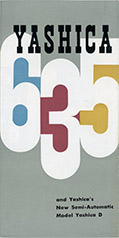 (Click on cover to view as PDF)
(Click on cover to view as PDF)
Yashica B
Mid-range model with plain filter mounts and film counter
Probable release date |
Nov 1958 |
Probable end date |
Dec 1961 |
Lens |
Filter Mounts |
Frame Counter |
Shutter |
|||
Make/Type |
Sync |
S/Timer |
Speeds |
|||
Yashikor |
36 mm |
Counter |
Copal |
X |
Yes |
B,1/25-1/300 |


(Left image courtesy of Sumanta Chandra, centre image courtesy of Göran Årelind, right image courtesy of Tom Heckhaus)
The earliest examples have the stylised “Y” focusing hood logo on black leatherette (see also below), just under half have the narrow “Y” on gold background on either black or grey leatherette (image immediately below) and the rest, the most recent examples, have the narrow “Y” on blue background.
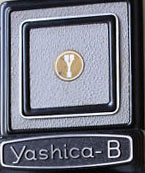 (Detail from larger web image)
(Detail from larger web image)
Cameras with 1961 serial numbers (“B” prefix) are only found with black leatherette. There were no coloured 66 cameras of any model after December 1960.
This model also has an almost exact Yashicaflex clone, the Yashicaflex A (new model) which was released a year earlier. The Yashica B has Yashikor lenses with plain filter mounts and the basic Copal shutter from the Yashica A without slow speeds, all mounted in a lens panel type normally found on Bay 1 type cameras. Apart from trim, it is a Yashikor lensed Yashica A with self-timer, auto-stop winding and a fresnel viewing screen added. In other words, it fits between the entry level Yashica A and enthusiast D in both price and specifications (production of the Yashica C ceased at around the time of the release of the models B and D). All have trim details and serial number patterns consistent with the early Yashica D and therefore it was probably released at or very near the same time. It came in light grey leatherette and black metalwork as well as all black. It appears to have arrived in black and ended in black but like the Yashica Auto, both grey and black versions seem to have been available concurrently.
It is found with both meter and feet focusing scales and both are found with the ® mark suggesting an export only model. Japan had the equivalent Yashicaflex A (new model). However, this is an uncommon camera. The only ads or brochures that I have seen it in are two 1959 ads by the Singaporean importer (Singapore Free Press 8 July and 27 Oct) and a 1961 Swedish brochure. It seems to turn up more often in Europe than anywhere else and I suspect that was the target market.
There are 32 cameras in my database. Correspondent Sandra Hart has sent me details of her late father's camera. This is from the UK and was the earliest in the database with 8 digit serial number 38110112 and taking lens 458553. It is black with the black-white-black stylised “Y” focusing hood logo and the name between the lenses is the earlier “Yashica” in the oval:
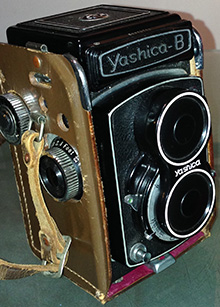
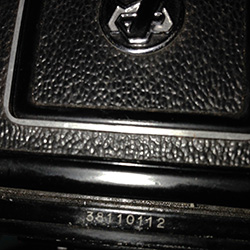
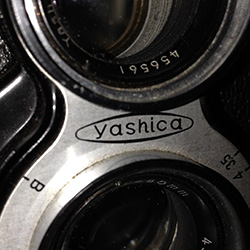
(Images courtesy of Sandra Hart)
Correspondent Sumanta Chandra has since sent me details of his camera, featured at the top. It has earlier serial number 38100079 and taking lens 253807 and viewing lens 446119 but in other respects, it is the same as Sandra's example.
The third (38110xxx) and fourth cameras (38120xxx, December 1958) are still the same and all have feet focusing scales. The fifth camera has new 7 digit body number 3920xxx (February 1959) and lenses 279xxx and 481xxx. It is the first example with grey leatherette and the first with the narrow “Y” hood logo on a gold background. The sixth and seventh cameras with serial numbers 393xxxx (taking lens 491xxx) and 3930xxx are again all black and are the last with the oval logo between the lens. 393xxxx is the first with the focusing knob scale is in metres after which they appear in roughly equal numbers until dual scale knobs. The next camera, 3940xxx, has grey leatherette and the “Yashica” between the lenses is in block letters as on all following cameras. The focusing scale in feet. The following camera, is the same. Then there is black camera 394xxxx followed by grey 3941xxx, both with the focus scale in metres. Then there are four all black cameras again, all starting with 3950xxx and with taking lens numbers 299xxx, 500xxx, 300xxx and 503xxx respectively. The focusing scale on the first is unknown but the second is in feet and the third and fourth are in metres. The second of the group is the first with narrow “Y” hood logo on a blue background but the third camera has gold again and on the last, the logo is missing.
The next camera, grey, begins a new 6 digit series with number 620xxx and new taking lens series 575xxx, and now the narrow “Y” hood logo on blue background appears consistently on both black and grey examples. The following example, also 620xxx, is the same and both have focusing scales in feet. The subsequent cameras all have dual scale focusing. As well as these two, the next four examples are grey the last of which is 640xxx with taking lens 601xxx. This is followed by the last in the series, 660xxx, which is black as are the rest of the examples. The “B” serial number prefix was introduced with B 1030xxx followed by B 1060xxx and B 1080xxx. The last two examples both have serial numbers B 1120xxx with taking lens numbers 782xxx and 794xxx.
Yashica D
Knob wind premium model with control wheels
Probable release date |
Nov 1958 |
Probable end date |
1972 |
Lens |
Filter Mounts |
Frame Counter |
Shutter |
|||
Make/Type |
Sync |
S/Timer |
Speeds |
|||
Yashikor |
Bay 1 |
Counter |
Copal MXV |
M/X |
Yes |
B,1-1/500 |
Yashinon |
Bay 1 |
Counter |
Copal MXV |
M/X |
Yes |
B,1-1/500 |
| Yashinon and f/2.8 viewing lens replaced Yashikor Jul 1970 | ||||||
(Click on first cover for PDF of full manual)
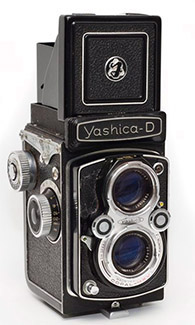
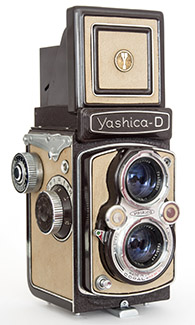

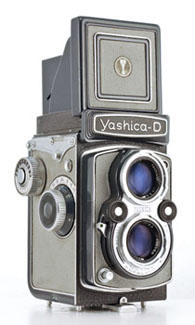

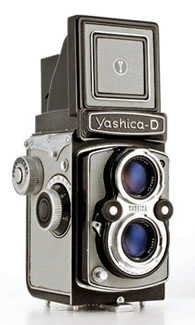
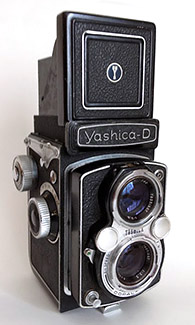

(Image 1 courtesy of Peter Heeling, images 2, 3, 4, 6 & 8 courtesy of Tom Heckhaus, image 5 courtesy of Dillon Ang & image 7 courtesy of Sandu Baciu)
Like most of the very small number of black cameras in this period, black camera 1 has a serial number which puts it between camera 2 and 3. However, it has the same trim as the two very earliest Yashica Ds (see below).
Missing from the above is the earliest Charcoal Gray (grey/grey) version with grey inserts in the control wheels and “Yashica” in the oval between the lenses, the same as the first brown one above. Grey is the earliest type in my database and continues with that colour and trim on later Japanese market examples, see below, when export models have adopted the black radial wheels and block text for “Yashica” between the lenses. Also missing is the Golden Brown (light brown) version shown below next to the camera left view of the Burgundy (dark brown) camera from above:
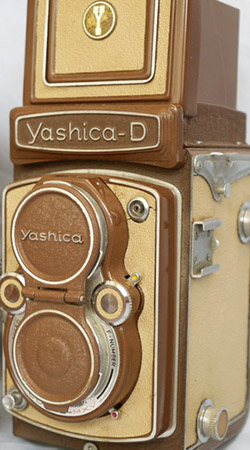
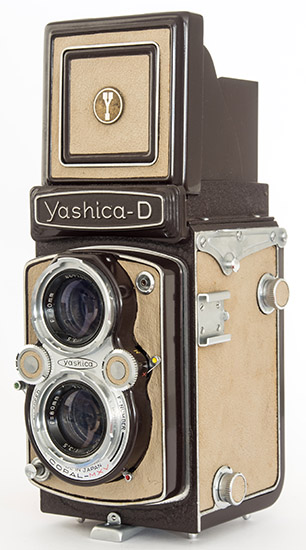
(Left image detail from larger web image, right image is Tom Heckhaus camera from above)
This particular example belongs between the first grey cameras (not shown) and the first brown cameras.
According to Karl Kahlau's Yashica/Kyocera documentation, the Yashica D was released a few months after the Yashica 635. He doesn't have an end date but according to the website “A Partial History of Yashica TLRs”, using similar source material, it lasted until 1972 or 1973. By serial numbers, I have found evidence of production up to 1971 so far to which Hong Kong production has to be added (see below), making 1972 feasible.
As already noted, this is a rebadged Yashicaflex B (new model). Apart from trim, it is the same as the Yashica 635 less the ability to use 35 mm film. It has the Rollei type control wheels, Copal MXV shutter and for most of its life, Yashikor lenses. The model history parallels the Mat and 635 with the Yashica A thrown in for colour.
Over time, Yashima had used and re-used the letters “A”, “B” and “C” to mean various things and I think that by this point, “D” was simply the next available letter in the alphabet. It certainly did not develop from the Yashica C, not directly anyway.
Early examples with metre focusing scales and also internal light baffles (see further down) are not uncommon and seem to be a direct domestic market replacement for the Yashicaflex B (new model) which seems to have ended production when the Yashica D was released. In fact, unlike the export version, the early domestic Yashica D and Yashicaflex B (new model) were identical except for colour, nameplate and the combined DIN/ASA scale on the D.
Yashinon lenses (with f/2.8 viewing lenses) didn't arrive until 1970. These, and the last of the examples with Yashikor lenses, have MXV shutters with 5 curved aperture blades instead of 10. (See Shutters.)
Serial Numbers and the First Yashica D Examples
The Yashica D arrived when date coded serial numbers had already been implemented across the range of models over 12 monthly previously (see Serial Numbers page). However, for some unknown reason, the Yashica D, like the Yashica 635 and Yashica 44 before it, started with what look like typical consecutive numbers from before the date code period, the D with 6 digit numbers and the 635 and 44 with 5 digits. The Yashica D is claimed to be released in November 1958 and the earliest date coded numbers in my database start in November already with serial number 38110xxx, however, the first two cameras, both black examples, have 6 digit serial numbers in the 582xxx range. They could be from earlier in November but with a November release, could have already been made in September or October.
Whilst it is tempting to believe that the “58” represents the year 1958, that is possibly not the case. There is clearly no month code so it is certainly not a typical Yashica date coded number. Being released several months earlier in 1958, there are many more examples of the early Yashica 635 with 5 digit numbers and whilst maybe half also begin with “58”, the first numbers begin with “56” and there also “59”, “60” and “61” numbers. So for the 635, “58” 5 digit numbers seem to have nothing to do with the year (there are later 7 digit “58” numbers which are date coded).
Below is the earliest of the two similar cameras, in other words, the earliest Yashica D in my database, 582401, owned by correspondent Jaime Suárez Martínez:
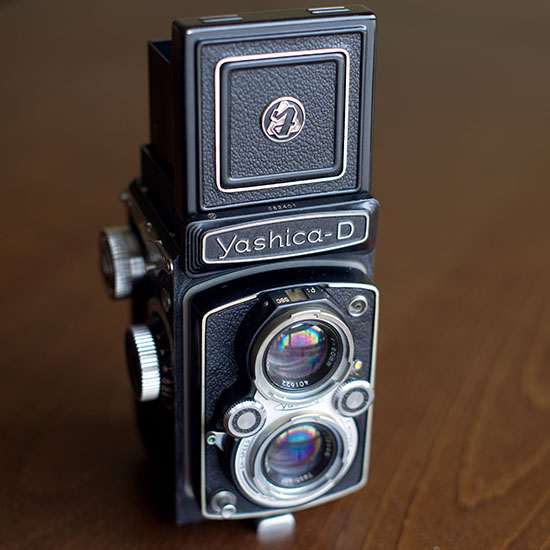
(Image courtesy of Jaime Suárez Martínez)
The second camera is only 20 or so examples later. Whilst other than Jaime's camera, that has the lowest typical taking and viewing lens numbers from the period (427xxx and 429xxx respectively), Jaime's camera has an even lower viewing lens number, 401622, and the taking lens, 232646, is by far the lowest of a second range of early taking and viewing lenses (the two series mixed in together).
Both cameras have metric focusing scales and accessory shoes with 4 screws like the domestic Japanese market models but both feature the ® mark only found on export versions and Jaime's doesn't feature the internal light baffles of the Japanese version (the other is not visible). Jaime's camera was purchased in Europe, the other was found on US eBay but the metric focusing scale suggests that wasn't its original market.
Unusually, and uniquely for a Yashica D, Jaime's camera features “Made in Japan” in the accessory shoe. The only other 66 cameras to feature that are the first examples of the Yashica 635.
Colours & Trim
The colour combinations found are similar to the Japanese market Yashica A III (the export Yashica A has a more limited palette) except for the addition of a light brown which equates to “Golden Brown” in the Yashica 44 colour palette whereas the dark brown of the Yashica A and D is probably called “Burgundy”. Whilst there are five Burgundy versions in my database, it took a long time before contributor Leigh Harris spotted the first Golden Brown example on a UK website. Until then, it was unknown to me but a second one has now turned up on a Japanese auction site. Anything other than black leatherette is restricted to the 1958 to 1960 period:
Colours Found |
||
Metal |
Colour Name |
Leatherette |
| black | black | |
| black | grey | |
| grey | Charcoal Gray | grey |
| dark brown | Burgundy | warm grey |
| light brown | Golden Brown | dark cream |
The early cameras up to 38121xxx (December 1958) have only been found with metric scales. All the colours appear in this period except for grey leatherette/black metalwork. After that example, most cameras have feet scales and most cameras have grey leatherette/black metalwork. The rest are grey/grey (except for four black examples). Most of the grey/grey examples seem to be Japanese market versions (see below).
The folding metal lens caps from this period matched the metalwork colour as it seems that the square metal lens hoods did. There is a photo of black, grey and brown lens hoods together on a Japanese site and I have seen a grey one for sale with a matching Yashica D.
As mentioned above, the earliest two cameras are black cameras. They have the black leatherette inserts in the control wheels and early type hood logo (second camera above) found on Yashicaflex B (new model) and Yashica 635 and Yashica-Mat (gold “Y” on white triangle instead of black “Y”) examples until the very end of 1959 when the narrow “Y” on blue background was adopted for all models. The next Yashica D examples in my database already have coloured leatherette with the narrow “Y” focusing hood logo on a gold background.
Then come the next four of another five black examples in the colour period, with serial numbers 3910xxx to 3920xxx (January to February 1959). I think that this four and the first two they were destined for Europe for the reasons noted further below. The seventh black example, 3990xxx, is from September 1959 and has the black radial control wheels, gold hood logo (now like the black Yashica B and Yashica Auto, both also available with coloured leatherette) and focusing scale in feet of its coloured contemporaries (it is amongst the last of the gold logos before blue logos arrived):

(Image courtesy of Dillon Ang)
This is the same example as at the top. Correspondent Dillon Ang kindly sent me details of his camera. It came in a grey case which is probably original and the only colour produced during the time of coloured cameras.
The only example with the 9 flag film speed reminder on the film winding knob so far is the example in the early user manual. All others I have found have the later silver/black DIN/ASA scale.
Internal Light Baffles
The two earliest coloured Yashica Ds in my database, both with serial numbers 38110xxx which I presume is from November 1958, and the fourth earliest with a similar serial number owned by contributor Sandu Baciu are grey examples with the same internal light baffles as the Yashicaflex AS and B (new models). I have clear photos from Japanese sites of another two early examples (serial numbers not visible) with brown metalwork and baffles and Sandu has a similar example with body serial number 3812xxxx and taking lens serial number 462xxx. The camera below left is number 38123194 owned by Tom Heckhaus (also featured above). Grey camera 3940xxx from April 1959 has the same trim and features. However, seven later grey cameras, three with serial numbers in the 3950xxx range (one owned by contributor Leigh Harris), the camera below right with November 1959 number 410xxxx and three with 1960 serial numbers 610xxx to 620xxx (another of which is also owned by Leigh Harris), have the more abbreviated baffles that reappeared on the Yashica Mat-124G 10 years later.
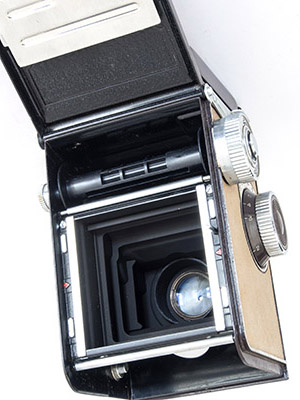
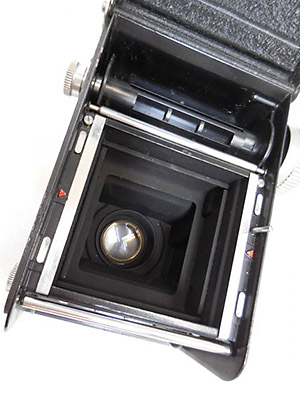 (Camera 2 detail from larger web image)
(Camera 2 detail from larger web image)
All have metre focusing scales and therefore were almost certainly intended for the domestic Japanese market (most in my database have originated from Japanese auction sites). See also “Japanese Market Yashica Ds” a little further below.
There are at least eight more examples with the small baffles. Like the rest, these are now black cameras with dual scale focusing knobs and look the same as export models except for the 4 screw accessory shoe. The first has late 1960s taking lens serial number 600xxx. The next is the first Yashica D with the dull silver control wheels (lens numbers 600xxx and 603xxx). Nine digit serial number camera 126110xxx (lenses 656xxx and 655xxx) reverts to black leatherette rings in the control wheels. The following camera is back to the dull silver control wheels (lenses 673xxx and 6667xxx). The next camera is definitely from 1961 and the serial number might be D 1080xxx with both lenses in the 751xxx range. D 1110xxx follows. The second last camera with baffles has lens serial numbers 944xxx which places it right next to the last camera with serial number D 2110xxx with taking lens 945xxx, probably from November 1962. Unfortunately most cameras don't have the insides visible. There are more examples with the Japanese market accessory shoe (see below) in my database but by the early 1960s, they are becoming quite rare and the last is camera D 4090xxx (from September 1964) before the 4 screw type is universally adopted in 1967 - unfortunately the inside of the camera is not shown.
See “Internal Light Baffles” for more detail.
Accessory Shoe
By the time that the Yashica D arrived, accessory shoes were secured with four screws. The first Yashica Ds in my database have metre scale focusing and presumably were intended for the Japanese market and the black ones for Europe.
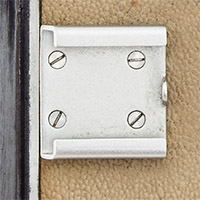
Shortly afterwards, around February 1959 and camera 3921xxx, examples with feet scale focusing and black radial control wheels appeared in large numbers, in fact swamping the odd example with metre focusing scales. On these cameras only, the shoe changed from a pressed metal type to an extruded alloy type with the only visible screw being the screw in stop post:
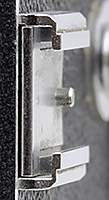

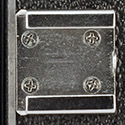
(Image 1 courtesy of Göran Årelind, images 2 & 3 courtesy of Tom Heckhaus)
In fact, there are another two screws in the front under a cover plate. There is also a flat spring in each groove to positively grip the flash, or other accessory. The shoe reverted to the simpler four screw style in 1967 (camera D 7090xxx). On late cameras, starting July 1968 or a little later, the slotted accessory shoe screws were replaced with cross head types (almost certainly Japanese JIS standard rather than Phillips - tight screws can be damaged by a Phillips driver). Note, the strap holder screws also changed but not until about April or May 1970.
For the period that the extruded shoe was in use, my database also includes seemingly random three screw types. It seems that these either have the cover plate missing or have had the shoe replaced with an earlier type which probably use the same holes. Nevertheless, there are at least ten such cameras. As noted above, Japanese market Yashica Ds continued with the four screw type and were either not fitted with the extruded shoe at all, or received it much later. The last confirmed Japanese market type Yashica D in my database is camera D 4090xxx from September 1964. This still has the four screws.
Japanese Market Yashica D
Coloured cameras with metre focusing scales seem to have three other things in common; internal light baffles, four screws in the accessory shoe when contemporary cameras use the extruded type with cover plate and they continue to use the leatherette rings in the control wheels after the introduction of the black radial type (both were replaced by the dull chrome type very shortly after the cameras reverted to all-black). It seems that all these features appeared together in the Japanese market version - there are examples where not all the features are visible but there are no contradictions. Also, the coloured cameras are unlikely to have black metalwork. Grey/grey was the most common but the earliest cameras were just as likely to have brown metalwork.
One other common feature is that earlier Japanese market cameras also continued with “Yashica” in the oval between the lenses after export cameras adopted block lettering in February 1959, but only until May 1959 when the Japanese version changed as well.
As noted in “Baffles” and “Accessory Shoes” above, there are also some early 1960's all black cameras, the last from 1964, with 4 screws in the accessory shoe. These now have dual focusing scales and apart from the accessory shoe, the only other difference to the export models are the internal light baffles (not visible on the 1964 example).
There is a 1959 Japanese brochure (it includes the Yashica A III and short production run Yashica Auto) with a Yashica D without hood logo on the back cover. None without logos have been found in the wild and I suspect its a pre-production example but you never know. Incidentally, the Yashica D was released in November 1958 and as alluded to earlier, it seems from my database that except for a small number of black cameras, all November and December production went to Japan.
European Market Yashica D (Early Black Examples)
The two earliest black cameras with 582xxx serial numbers and the next four early black cameras mentioned above, with serial numbers 3910xxx to 3920xxx, have focusing scales in metres from the period just before cameras with feet scales swamped production. In common with the Japanese market cameras, they have the leatherette inserts in the control wheels, “Yashica” in the oval between the lenses and accessory shoes with four screws. The only item that they are missing are internal light baffles (two out of six, other four interiors are not visible). Four of the six have a European history (one was for sale in the US and the sixth is unknown) and five of the six have the ® mark which is not evident on Japanese market cameras (top of nameplate is not visible on one of the cameras).
As a point of difference, Yashica-Mats sourced from Europe do appear to retain their baffles for the relevant period. These may have been lower volume without a specific export type or may simply have been subject to a different marketing strategy.
Shutter Speed Range
In Shutters, I note that in 1958, Yashica began to introduce the “modern” shutter speed range of 1, 1/2, 1/4, 1/8, 1/15, 1/30, 1/60, 1/125, 1/250 and 1/500 to replace the “old” range of 1, 1/2, 1/5, 1/10, 1/25, 1/50, 1/100, 1/250 and 1/500. Several correspondents have mentioned that their 1960 and beginning of 1961 Yashica Ds still have the old speeds.
Trim & Feature Changes by Serial Number
All the coloured cameras are in a block, similar to the Yashica A pattern, near the beginning of Yashica D production with only a very small number of black cameras in this period. Out of 239 Yashica Ds in my database, 57 are coloured (therefore, 60 of the 188 cameras are from 1960 or earlier). There are 29 grey/black, 19 grey/grey (rare), 5 warm grey/dark brown (very rare), 1 cream/Golden Brown (extremely rare) and 3 with grey leatherette but unknown metal colour.
First are the two black cameras with 582xxx serial numbers. The first coloured camera, serial number 38110xxx with taking lens 452, has grey leatherette and grey metalwork, grey inserts in the control wheels and the narrow “Y” hood logo on a gold background. The second camera also has taking lens 452xxx. It is interesting because it has a matching grey lens hood. The next camera is still 38110xxx, some 500 cameras after the first and with the same trim still. The fourth camera is the Golden Brown example with taking lens 453xxx and viewing lens 259xxx. This is followed by 38111xxx with warm grey leatherette and brown metalwork with taking lens 454xxx and viewing lens 259xxx. Up to serial number 38121xxx is a mix of warm grey and brown and all grey examples.
The next three cameras are the third, fourth and fifth black cameras with 7 digit numbers 3910xxx to 3911xxx (1959, January) and taking lenses in the 269xxx range for the first two. Then there are two Japanese market coloured cameras with the same range serial numbers but lens numbers from the second lens number range, 473xxx and 476xxx. The sixth (and last) of the early black examples is next with serial number 3920xxx and taking lens 276xxx. After these examples, all following export cameras have the name in block letters. With the coloured cameras up to this point, the leatherette ring inserts of the control wheels have matched the camera coverings.
Next camera, 3921xxx, is the first example with the focusing scale in feet. From now until dual scales, focusing scales in feet predominate. The following cameras continue with 7 digit numbers and are mainly grey/black with the odd grey/grey thrown in. The cameras usually have black radial control wheels, the first four, up to 3922xxx (all grey/black) have red centres with white rings, the ones after that have white centres. Two grey/grey cameras, 3931xxx and 3932xxx, have the black radial wheels with white centres but the other grey/grey examples have the grey leatherette rings in their wheels as well as focusing scales in metres and also accessory shoes with four screws - almost certainly Japanese market cameras.
The last in this series is 3990xxx, the seventh of the black cameras and the only black example with the gold hood logo.
Then there is a new series of numbers starting with 4100xxx. Between camera 4101xxx, with lens number 536xxx, and 4102xxx, the gold focusing hood logo background changed to the blue background. There are a number of cameras with 4102xxx numbers and these are the last in the series. The next block has 6 digits. The first is 610xxx (lens 564xxx) followed by a camera with taking lens 565xxx and camera 611xxx (lens 567xxx). At 621xxx, the focusing knob changes to dual scale (before this, there has been a mix of feet and metre scales with feet being a slight majority and predominant towards the end and meters being exclusive in the beginning). 631xxx is the last coloured camera. The next camera, 641xxx (lens 598xxx), is black and is the last camera in this series. Probably.
There are two in-between cameras with taking lens numbers 648xxx and 666xxx (viewing lenses 647xxx and 671xxx) which I know very little about including control wheel trim. These are just before or just after camera 126110xxx with 9 digit serial number and therefore may also have 9 digit numbers. Camera 126110xxx, with lens numbers 656xxx and 655xxx, is the only confirmed Yashica D found so far with this type of number but it is not alone as far as other models are concerned. This particular example is a black Japanese version with light baffles, four screw accessory shoe and black leatherette rings in the control wheels still. Text between the lenses is the wild west block letters type. (I thank contributor Leigh Harris for identifying this camera.)
D 1020xxx, taking lens number 680xxx, is the first in the new series and also introduces the new plain mat silver control wheels. D 1051xxx is next with taking lens number 709xxx and viewing lens 708xxx. The Yashica D lost the two external pressure plate screws on the back between D 2080xxx and D 2110xxx. Between cameras D 3010xxx and D 3040xxx, lens serial numbers got to 998xxx at which point they seemed to start again with 149xxx. At around D 4041xxx, the lens caps changed from hinged alloy to the first plastic type with tab. At around D 5110xxx, the control wheels changed to the shinier reflective type and the plastic lens cap changed to the 2nd type plastic without tab. My January 1966 camera D 6010254 (taking lens 400282 and viewing lens 401134) is the first with the wide “Y” hood emblem. At around D 7072xxx, the parallel bars on the hood changed to black. Between cameras D 8020xxx and D 8040xxx, the satin black focusing hood blind changed to a textured finish.
Between cameras D 8070xxx and D 8100xxx, the slotted accessory shoe screws changed to a cross head type (probably JIS). The numbers run up to D 9121xxx (taking lens 949xxx and viewing lens 947xxx) which I believe is December 1969. Between camera D 0040xxx and D 0060xxx (April and June 1970) the strap holder screws also changed from slotted type to cross head type. Before these two is camera D 0030xxx (March 1970) with a Yashikor viewing lens and Yashinon taking lens. Even though it is near the end of the Yashikor period, I doubt very much that the Yashinon is original. D 0061xxx still has both Yashikors with taking lens number 998xxx and the next two taking lenses, 1000xxx and 1001xxx are also still Yashikors.
D 0080xxx is the first camera with both Yashinons (taking lens 984xxx) and the viewing lens is an f/2.8 without serial number as are all subsequent ones. Camera D 0100xxx is the first with the new heavily patterned nameplate (see Hong Kong below) also found on the late Yashica 635 and Yashica-Mat and reminiscent of some 16 year older models like the Yashima Flex and Yashica Flex B and the 1965 Yashica 24. Camera D 0101xxx, Yashinon lens 1027xxx, is the first with the black plastic locking knob from the Yashica Mat-124G instead of the chromed metal type. By the time that numbers reach D 1021xxx, they look like they are in danger of repeating the beginning of the D series from 1960. Body numbers climb to D 1092xxx and taking lens to 1066xxx. The last camera has a different locking knob. Instead of “Made in Japan” engraved and left black, it has “Japan” in filled white letters like the last of the Hong Kong examples (see below):
 (Detail from larger web image)
(Detail from larger web image)
Other models with black locking knobs continued with “Made in Japan” including all examples of the Yashica Mat-124G that I have seen.
There are 40 examples in my database (including the Hong Kong ones below) with the Yashinon lenses - about 1 in 5 of Yashica D examples which is significantly higher than Yashica 635 examples and also Yashica-Mats with f/2.8 viewing lenses.
Hong Kong
There is a group of fifteen cameras in my database with late features including cross head screws for both accessory shoe and strap holders, textured nameplate, Yashinon taking lenses and unnumbered Yashinon f/2.8 viewing lenses, just like the previous examples. However, they, or at least some of them, are clearly made, or assembled, in Hong Kong. Unlike the previous Yashica D examples, the serial numbers are six digit and appear to be consecutive without any date code. All are prefixed with an “H”. There are references on the web, including by the Yashica Guy, to 35mm cameras being assembled in Hong Kong but I have found nothing about TLRs. The 35mm cameras also have the H prefix. I have seen no evidence of other Yashica TLR models being assembled there.
Like the 1971 Yashica Ds, they have the black locking knobs inherited from the Yashica Mat-124G. Except for the first two and the last three, the locking knobs are engraved with “Hong Kong” instead of “Made in Japan”. Detail from camera H 103763 (lens number 741691) is featured below (note absence of “Made in Japan” under the taking lens):
.jpg)
.jpg)
.jpg) (Images courtesy of Leigh Harris)
(Images courtesy of Leigh Harris)
Both the earliest example, serial number H100377 with lens 717203 owned by correspondent Bernard Martinez, and second earliest, owned by correspondent Dawid Konofalski, with numbers H 101xxx and 733xxx, still have “Made in Japan” on the black locking knobs but there is no “Made in Japan” under the lens as found on Japanese made Ds.
The last three in my database have “Japan” with filled in white letters on the locking knob instead of the plain “Hong Kong” or “Made in Japan” of the majority of Japanese made cameras (the very last Yashica D without a Hong Kong serial number also has this type of knob - see above). They also revert to displaying “Made in Japan” under the taking lens:

 (Images courtesy of P. Ferrer)
(Images courtesy of P. Ferrer)
This example is the last one in my database, i.e. with the highest serial number. At face value, these three appear to be made in Japan but retain the Hong Kong numbering. It is possible that Yashica decided to be cute about whether “assembled” meant “made” or not but there is no way to know what was really going on.
The found camera serial numbers in my database run from H 100xxx to H 113xxx and the Yashinons from 717xxx to 795xxx which are shared with August to October 1971 (last) Yashica 635s and 1971 and 1972 Yashica-Mats and Yashica Mat-124Gs.
Brochures are circa 1958 or 1959. The first is Japanese, the second features both the Yashica 635 and D:
(Click on covers to view as PDF)
Yashica A III
aka Yashica AIII, Yashica-AIII, Yashica A variant
Probable release date |
Apr 1959 |
Probable end date |
Aug 1960 |
Lens |
Filter Mounts |
Frame Counter |
Shutter |
|||
Make/Type |
Sync |
S/Timer |
Speeds |
|||
Yashikor |
32 mm |
Red Window |
Copal |
X |
No |
B,1/25-1/300 |
 (Click on cover for PDF of selected pages of Japanese manual provided courtesy of Chris Whelan)
(Click on cover for PDF of selected pages of Japanese manual provided courtesy of Chris Whelan)
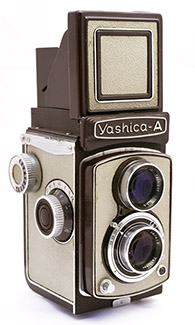
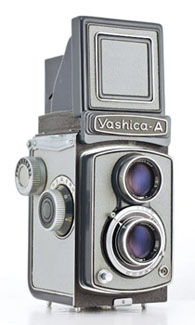
(Examples with brown and grey metalwork, images courtesy of Tom Heckhaus)
Sugiyama has a photo in his book of what looks like a grey Yashica A but without a hood logo. The specifications are identical. He calls it a Yashica-AIII with a release date of 1959. A Japanese ad features both the 1959 Yashica Auto and A III - the photo of the latter is clearly a Yashica A in some form:
 (Detail from larger web image)
(Detail from larger web image)
Note: Most/all Japanese brochures (including the one further below) and the user manual, linked above, show the camera with a hood logo. Either the photos are of an export Yashica A (there is plenty of evidence of Yashica cutting costs by using existing images), or the deletion of the hood logo was a last minute decision.
Contributor Chris Whelan has bought an A III from Japan complete with Japanese language user manual and the guarantee document below with serial numbers matching the camera (this is the third such document I have seen):
 (Document image courtesy of Chris Whelan)
(Document image courtesy of Chris Whelan)
The fact that the camera has no hood logo and serial numbers match is a clear indicator that the variant without hood logo is the A III.
My database has forty of these coloured Yashica A based cameras. The first two cameras in the database have grey metalwork with grey leatherette. Then there is one with black metal work and grey leatherette (only one other, about halfway through). Another two all grey and then a group of five with brown metalwork with warm grey leatherette. The remainder are the all grey type. Another example of the brown with warm grey leatherette plus matching brown lens cap:
.jpg)
.jpg)
(Both images courtesy of Leigh Harris)
These are the colour combinations found. The dark brown version probably equates to Burgundy in the Yashica 44 colour palette and the grey to Charcoal Gray:
Colours Found |
||
Metal |
Colour Name |
Leatherette |
| brown | Burgundy | warm grey |
| black | grey | |
| grey | Charcoal Gray | grey |
Whilst most early Yashica As have feet scales (those with metre focusing scales had the 10 flag DIN film speed reminder and were certainly Europe bound), all of the Yashica A III types have a metre focusing scale whilst the last four in my database have dual scale focusing knobs. All seem to have the later combined DIN/ASA film speed reminder on the film winding knob.
Given the feet scales of most early Yashica As, my thinking is that the almost identical Rookie (except for its 6 x 4.5 capability) initially fulfilled the Yashica A's role domestically followed in 1958 by the similarly specified, but with shutter cover plate, Yashicaflex A (new model) which was also marketed in Japan as the “Yashica A” and that the Yashica A III was released later to offer the option of different colours. It was called “A III” because “A” had already been used. The majority of the cameras in my database have originated from Japanese websites and typically for Japanese market cameras, there is no ® mark on top of the nameplate found on export cameras from the same period nor “Made in Japan” or “Japan” in the accessory shoe, as found on the corresponding Yashica A examples (note that as well as the hood logo, the user manual shows “Made in Japan” in the accessory shoe suggesting that the photo is of an actual Yashica A).
Camera boxes are identical for all three models (Yashica A, Yashicaflex A and Yashica A III) including the English text on the box and Yashica A and A III ever-ready cases are also identical. A III with box, case and documentation (owned by Chris Whelan, this is a different camera and guarantee document than referred to earlier, albeit the same type of guarantee):
 (Image courtesy of Chris Whelan)
(Image courtesy of Chris Whelan)
This far, body numbers have the following patterns; seven digit numbers 3933xxx to 3962 (1959 March to June), eight digit 39100xxx (1959 October), seven digit 4110xxx to 4120xxx (1959 November and December) and six digit numbers 611xxx to 680xxx (1960 January to August). The Yashikor lenses in my database have two serial number ranges running concurrently, one range running from 28327x to 30318x (from the beginning to about halfway) the other from 49226x to 64454x (from the beginning to the end but with significant gaps).Taking and viewing lenses can be both from the same range, or one can be from the other range.
Dual scale focusing knobs were introduced between 611xxx and 661xxx.
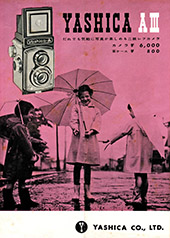 (Brochure scan provided courtesy of Leigh Harris)
(Brochure scan provided courtesy of Leigh Harris)
(Click on cover to view brochure as PDF)
Yashica Auto
Cheaper version of Mat
Probable release date |
Apr 1959 |
Probable end date |
Jul 1959 |
Lens |
Filter Mounts |
Frame Counter |
Shutter |
|||
Make/Type |
Sync |
S/Timer |
Speeds |
|||
Yashinon |
Bay 1 |
Counter |
Copal MXV |
M/X |
Yes |
B,1-1/500 |
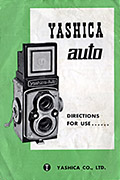 (Click on cover for PDF of full manual provided courtesy of Tom Heckhaus)
(Click on cover for PDF of full manual provided courtesy of Tom Heckhaus)
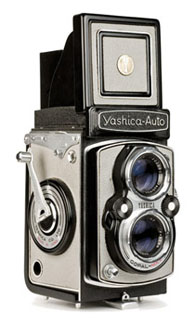
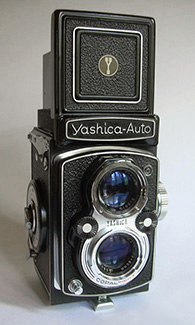
(Left image courtesy of Tom Heckhaus, right image courtesy of Leigh Harris)
Available in both grey and black, both Sugiyama and McKeown agree on a 1959 introduction as opposed to 1957 for the Mat. From trim details, this is about correct because the camera has features that didn't appear until later in the Mat (and Yashica D). These include the later locking lever, the narrow “Y” hood emblem, the “Yashica” name is in block letters between the lenses and the control wheels are black radial. The name on the circular cover plate under the crank and also on the boxes is “Yashica Co., Ltd.” like the later Mats whereas the early Mats had “Yashima Opt. Ind. Co., Ltd.” and before that, the examples with Lumaxar 75 mm lenses had no writing under the crank.
This is a rare short lived camera, possibly produced over only three months, according to my serial number date code theory, from March 1959 to May 1959. It was a cheaper version of the Mat most probably released for mainly the domestic market - all of the examples found have metre scale focusing knobs. This would fit with Sugiyama’s common rating. There is one Japanese ad of the Yashica Auto together with a Yashica A III and they also appear together in a Japanese brochure. I have found no evidence of any advertising of the model elsewhere in the world.
Nevertheless, there is an English version of the user manual (B&W scan available from OrphanCameras.com with a full “colour” but lower resolution version available from this site). In keeping with its budget status, the manual or “Directions for Use” is a more basic fold-out sheet rather than the booklet form for contemporary models and misses out on the aperture, shutter speed and exposure information normally provided. I haven't seen a Japanese version. Also, the two very earliest examples of the Auto have the ® mark which is not usually found on Japanese domestic market cameras (more here). It is possible that some were intended for export markets. A few of the cameras in my database have turned up from outside of Japan and contributor Tom Heckhaus has one of these, but, most have been found on Japanese auction sites (at one stage a number of them appeared for sale by an Australian seller but I suspect these were recent imports).
I say cheaper than the Mat because of both the lenses and advertised price. Barry Toogood has a Yashica Auto with Yashikor lenses but I very much doubt that these are original. The lenses in the user manual are “Yashinon” as they are on thirty six others where I can read the lens name. However, these “Yashinons” are all likely to be triplets, just like Barry's Yashikors. All other Yashinons on 6x6 cameras (except the automatic exposure Yashica E, presumably designed for the novice and hence also lower spec'd) have either f/3.2 viewing lenses or f/2.8 by the early 70s. Clearly, the f/3.5 Yashinon viewing lens on the Auto is a budget alternative. “Yashinon” is a brand name, not a formula like “Tessar”. As mentioned in “Lenses & Shutters”, the Japanese site TLR66.com seems (as translated by Google) to suggest that the lens sets on both the Yashica Auto and Yashica E are rebadged triplets. Japanese Wikipedia seems to repeat the claim regarding the Yashica Auto. Tests appear to confirm that. Also, a 1959 Japanese brochure confirms that Yashica 44LM Yashinons are 3 element so the precedent is clearly established.
A 1958 Japanese brochure lists the the Yashica-Mat at 21,500 yen and a 1959 Japanese brochure lists the Yashica Auto at 15,000 yen (the Yashica 44 prices didn't change from the first brochure to the second and the Yashicaflex B price in the earlier brochure is the same as the Yashica D, its replacement, in the later brochure). To me, that confirms the budget specs and that Yashica had no long term aspirations for this model - it would hurt both Mat and probably the D sales (listed at 11,000 yen) as well. If miracles happen and it had Tessar formula lenses, it would be a Yashica-Mat with a new nameplate and 33⅓% price drop (OK, the viewing lens would be lower spec but hardly justifying that drop) and who would buy a D if for only a little more, you could upgrade to Tessars and crank wind?
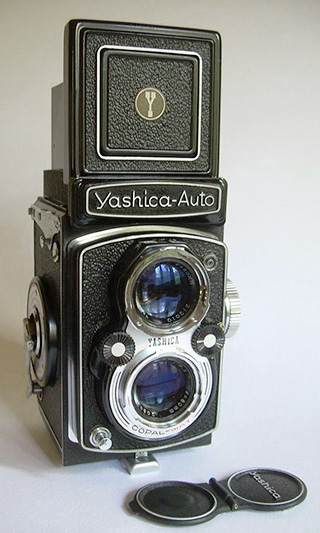
(Image courtesy of Leigh Harris)
This is the same black camera that appears at the top of the section
The lenses are the only practical difference between the Auto and Mat. Cosmetic differences are the nameplate, grey leatherette on around 2/3 of the cameras, the gold narrow “Y” logo which never appeared on a Mat, or any other crank wind ever-ready case, the cover plate under the crank has the colours of the graphics reversed with “Made in Japan” in red and as correspondent Randy Leist has pointed out, the background colour for the DIN and ASA scales was changed from white to yellow. None of that adds cost:


(Left image courtesy of Tom Heckhaus, right detail from larger web image)
The only definite variable during its production run was the availability of black or grey leatherette. There are thirty seven cameras in my database from 3930xxx to 3950xxx with lens numbers from 200xxx to 212xxx. The pattern from first to last is 4 grey cameras, 1 black, 23 grey, 8 black and 1 grey.
In grey, a pretty camera now sought after because of its rarity in the West. In black, rarer still. In other words, very collectible but not one for the user.
